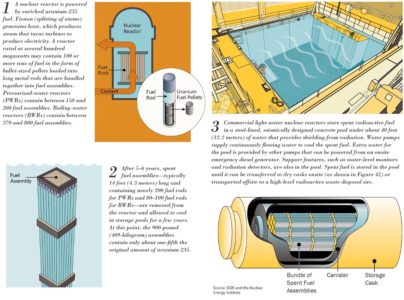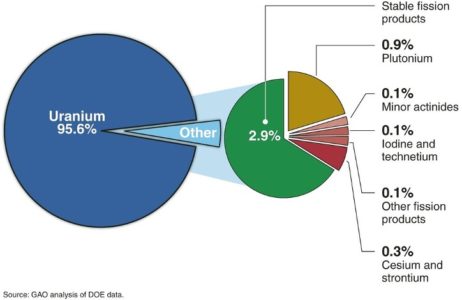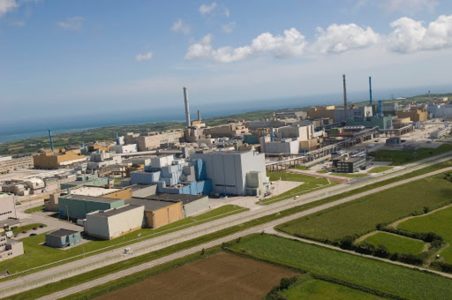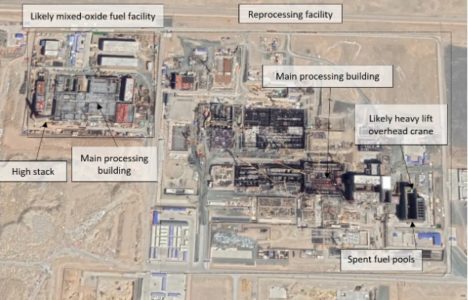Nuclear power has a nuclear waste problem. Here’s how to fix it.

Figure 3. Orano Nuclear Reprocessing Site, La Hague, France.
With concerns about climate change and sustainable energy sources taking center stage, a precious resource is being neglected. Most people don’t think of this bountiful, clean fuel that’s stored above ground across America and the world – as a valuable source of energy at all. By the name we have given it, we treat it as dangerous and worthless.
That resource is nuclear waste.
We can’t destroy nuclear waste, and the public doesn’t want it buried in the ground. So instead, it sits there. From the scenic coast of Maine and Vermont’s Connecticut River Valley to Savannah River in South Carolina and across the nation to the Pacific, it sits in casks to decay over thousands of years.
It’s a substantial source of green, carbon-free electricity to power the country for centuries, and it’s going to waste.
A recent Morning Consult poll found nuclear energy to have the second worst image after coal. Public opposition to nuclear power has been a particular hindrance to wider deployment despite the incredible track record of the American nuclear industry. Studies show that harmful byproducts from the generation of nuclear power are lower than almost any other source. So, what gives?
Spencer Weart, in his book The Rise of Nuclear Fear, contends that displacement of the fear of nuclear weapons and radiation on to nuclear power is partly to blame for its terrible public image. The main opposition to nuclear power coalesced during the Cold War around environmental groups.
And there is the NIMBY problem: Most of those who favor nuclear power in the poll paradoxically oppose storing nuclear waste within 20 miles of their own communities.
What is nuclear waste?
Nuclear waste – more accurately termed spent nuclear fuel (SNF) – refers to bundles of metal rods containing the remains of pellets of partially used nuclear fuel that became highly radioactive as they sustained nuclear fission.
Commercial reactors in America use tiny 1-cc pellets of ceramic uranium stacked in tubes made of a zirconium alloy. These fuel rods are then secured side-by-side in a grid pattern, housed in a stainless-steel assembly. A reactor core contains hundreds of such 15-foot-tall assemblies. After four to six years in the core, enough fuel is consumed that the rods cannot sustain a chain reaction in our conventional reactors, even though a large amount of untapped nuclear energy remains. The assemblies are removed and left to cool in spent fuel pools for about 10 years before being placed in containers called “dry casks.”
SNF contains three major radioactive components. About 95% is harmless uranium, similar to that found in nature. One percent is a synthetic byproduct, plutonium, with an average half-life of about 10,000 years, meaning it takes that long for half of the plutonium to undergo radioactive decay.
The rest is composed of highly radioactive material from the splitting of uranium – fission products – with average half-life of only about 30 years. The immediate health threat is from fission products while plutonium contributes to long-term radiotoxicity.
Right now, the United States considers all of this to be “waste,” something with no purpose that must be buried deep in the ground forever. Only one place in the country exists for safe burial, the Yucca Mountain site in Nevada, but the project has proven to be politically challenging. So, the casks of spent nuclear fuel just sit on the surface near their old reactors or at central collection centers.
What if, instead of dismissing these radioactive byproducts as worthless waste, we viewed them as valuable materials to be recycled into almost limitless, carbon-free energy?

The Center for Security Policy’s Tommy Waller raised this question in a recent article. Rather than being buried deep in the ground for tens of thousands of years, plutonium can serve as fuel for advanced nuclear reactors. His article called nuclear recycling a “new renewable energy” that can provide affordable and clean electricity for a thousand years.
This article builds on his piece, exploring the history of nuclear recycling, policy approaches in other nations that would benefit American energy needs, the implications of a US nuclear recycling program, and its effects on national security.
History of nuclear waste recycling in the US
US nuclear industry operates an “open” fuel cycle where SNF is ultimately destined for a geologic repository – an underground dumping site. This was not always the case. The US built and operated a few nuclear recycling facilities, chief among which was the Nuclear Fuel Services facility in West Valley, NY, which ran from 1966 to 1972. General Electric received authorization in 1967 to construct a facility in Morris, IL, but design problems halted the project. GE built a third facility in South Carolina.
Although construction was completed in the 1970s at a cost of $1.2 billion in current dollars, the facility never operated. President Carter withdrew federal support as part of a broader initiative to indefinitely defer SNF recycling in the US.

The seesawing of US strategy over what to do with SNF was governed by both domestic politics and naïve Cold War geopolitics. In 1974, India became the first non-permanent member of the UN to conduct a nuclear test. Its aftermath led to a serious reappraisal of proliferation and the role of nuclear reprocessing. With pressure mounting, just five days before his 1976 election loss, President Ford ordered a hold on nuclear reprocessing facility startups. Carter’s moratorium followed soon after, hoping that this move by the US would encourage other nations, including the Soviet Union and China, to follow.
After taking office in 1981, President Ronald Reagan lifted the ban on SNF reprocessing and called for development of a nuclear waste repository. The latter became law with the Nuclear Waste Policy Act (NWPA) of 1982. An amendment to NWPA in 1987 explicitly named Yucca Mountain, Nevada, as the site for a permanent nuclear repository. The legislation also established the Nuclear Waste Fund (NWF) into which utilities, and ultimately ratepayers, deposited funds to carry out disposal activities. The bipartisan approach was to dump expended nuclear fuel in the ground instead of recycling it for clean energy.
Current US nuclear waste policy
Under the NWPA law, the Department of Energy was scheduled to accept radioactive waste at Yucca Mountain by 1998. Litigation and political opposition had roadblocked the project. Then-Senate Majority Leader Harry Reid became Yucca Mountain’s most ardent opponent. His plans with President Obama to shutter the project were met with legal challenges. In 2010, the DOE with support from the Nuclear Regulatory Commission, then led by a former Reid staffer, shut down the project.
With the NWPA law still on the books, an appeals court ruled that Yucca Mountain could not be closed due to policy objections. Instead, Reid and his allies blocked federal funding, and work at the disposal site has remained on halt ever since. Meanwhile, a 2013 ruling allowed utilities to cease paying into the NWF, which had collected $24 billion from power companies between 1983 and 2014. As of 2020, the NWF treasury securities had a balance of about $43 billion, collecting $1.5B in interest annually.
On top of that, the federal government has used taxpayer funds and deficit spending to make billion-dollar annual payments to utilities for its failure to take custody of SNF. The payments come from the Judgment Fund – an essentially infinite pool of tax dollars to settle lawsuits against the federal government. Taxpayers have paid out more than $9 billion to date. Meanwhile, an estimated 80,000 metric tons of SNF has accumulated in the US – stored across 75 surface-level temporary sites in 35 states.
Benefits and challenges of nuclear recycling
The main reasons for recycling SNF are: (1) recovery and recycling of unused fuel, (2) large reduction of waste volume, and (3) eliminating the need for a geologic repository that the public does not want.
Waste from recycling will reach natural background levels of radioactivity within 300 years as opposed to unprocessed SNF which requires over 100,000 years – not suitable for our lifetimes, but certainly beneficial to future generations and the planet. The challenges are mainly in the realm of nuclear proliferation.
Tommy Waller’s article mentioned that today’s nuclear waste can provide carbon-free energy for a thousand years. Indeed, more than 90 percent of the extractable nuclear energy is still intact in SNF produced from American reactors. Simply recovering the plutonium and consuming it in existing legacy reactors, as is done in France, could produce the same energy as one percent of the world’s natural gas.
Then there is the potential for “breeding” new fuel to make the recovered plutonium a feed for starting fast-spectrum reactors like one that DOE has selected for demonstration. France, Russia, and China are years ahead of us on this. Such reactors can create a limitless supply of clean energy by breeding fuel from abundant uranium and thorium.
Nuclear reprocessing globally
SNF reprocessing is carried out as a matter of routine in France. The UK, Russia, Japan, and India also practice reprocessing at some level. France is the undisputed global leader. Its La Hague facility has operated safely for four decades. Only about half its capacity is used for domestic recycling, while the rest is for recycling foreign SNF.

Since operations began, the facility has processed over 34,000 metric tons — enough to power all of France’s reactors for 14 years.
Russia is integrating its nuclear recycling and fuel manufacturing infrastructure to prepare for an expansion of its nuclear industry with deployment of fast-spectrum reactors.
Meanwhile, China is speeding up its nuclear recycling program. It originally commissioned a pilot facility in 1986 but technical concerns delayed operation. Persuaded by arguments like the ones made here, and buoyed by French success, China began operations at the pilot plant in 2010. A demonstration plant is scheduled for 2025. In 2018, China launched preparatory work with the French company Orano for a commercial-scale facility. SNF recycling is part of a comprehensive Chinese plan to develop its domestic nuclear industry. As a side note, a 2020 Center for Security Policy article highlighted China’s thorium reactor program and its implications for US economic and national security.
The federal government created the problem…
Whether or not the United States goes along, nuclear power will play a critical role in supplying global energy needs. The rest of the world is moving towards advanced reactors and closed fuel cycles. The US, meanwhile, is saddled with a billion dollars in annual liabilities because of eighty-thousand metric tons of nuclear waste spread across the country with no place to go. Moreover, it possesses a $40 billion fund meant for dealing with nuclear waste which it forced ratepayers to pay into but has made inaccessible behind antiquated thinking and bureaucratic red tape.
Nuclear energy still produces one-fifth of the nation’s electricity. Not only is it carbon-free and sustainable, but also incredibly energy dense – pound for pound three million times more than coal. Nuclear has also proven to be one of the safest forms of power generation. However, the US continues to shut down its nuclear power plants in favor of more fossil fuels and currently impractical and unsustainable solar and wind sources.

Russia and China, on the other hand, have undertaken massive nuclear projects. State-controlled nuclear companies from both nations are leading nuclear plant construction in developing countries, going so far as providing fuel services, waste management, and project financing as part of the deal. Providing nuclear power to another country can be leveraged as an efficient soft-power tool in geopolitics, and a form of political control in exchange for keeping the power running. Our adversaries are replacing America’s lost leadership in establishing global nuclear norms.
With NWPA, the US government took up the responsibility of dealing with nuclear waste and essentially removed the possibility of market-based solutions. Instead, the ratepayers have paid large sums into a fund on behalf of the industry for an undefined service which has remained unrendered. Meanwhile, SNF has neither been buried nor recycled. It remains simply as a liability and wasted opportunity. Government regulations prevent private industry from even attempting a solution.
Other nations have not taken such a regressive approach to SNF. France, having turned to nuclear power as the US turned away in the 1970s, made recycling a central component of its energy strategy from the beginning.
Fear mongering by anti-nuclear activists has proven baseless. After more than a half-century, none of the anti-nuclear arguments, which border on conspiracy theories, have become real. To the contrary, nuclear technology has become safer and safer. The French have recycled SNF for 40 years without major incidents: no explosions, no deadly radioactive leaks, no terrorist attacks, no stolen plutonium, and no increased risk of nuclear weapons proliferation. Instead, the French have successfully put into practice innovations pioneered in – but rejected by – America. China is doing the same today. Not everything is perfect with France’s nuclear program, but the important point is that France successfully resisted the politics of nuclear waste.
As many as nine US states have laws on their books linking approval of new nuclear plants to demonstration of adequate waste disposal capacity. As discussed earlier, the issue of nuclear waste has been a focal point for public opposition to nuclear power. Reactor developers are being exposed to intense public scrutiny for having no clear means to deal with the SNF even though the problem is political and not technical or scientific.
Federal policy has failed spectacularly in dealing with the accumulated nuclear waste. In practice, the net effect of the implicit moratorium on nuclear recycling has been: (1) to make the American nuclear industry uncompetitive both at home and abroad, benefiting Russia and China; (2) many nations – allies and adversaries – are surpassing or have already surpassed the US in nuclear R&D, (3) US taxpayers are on the hook for $2.5 million a day in liabilities to power companies, (4) nuclear waste continues to accumulate in the US at a rate of 2000 metric tons a year with no solution in sight; and (5) an incredible source of clean, carbon-free, sustainable energy is being wasted.
…and the Federal government can help fix it
France proves daily that SNF recycling is not only feasible but also a safe and affordable technology that should be part of America’s clean energy program. If the US is serious about reducing its carbon emissions, it must get serious about nuclear power. That seriousness starts with a comprehensive solution to SNF. Not only would nuclear recycling provide a valuable energy source, but it would also signal to the world that the US is reclaiming its leadership in clean energy production.
There has never been a better window of opportunity than now for the US to pursue recycling as an avenue to solving the SNF issue. The new Administration has stated that it does not intend to resume work on Yucca Mountain, so nuclear recycling would do no harm to existing efforts there. The other major criticism – that few reactors can use reactor-grade plutonium – is already being addressed in DOE’s reactor demonstration program.
Congress should explore nuclear recycling as a viable option. Because the SNF problem was created by the government, it cannot be solved merely by private enterprise. Congress can start by commencing an R&D program, much like the advanced reactor programs of recent years, to spur innovation and bring novel nuclear recycling technologies out of national labs and into commercial development.
Congress should encourage private sector participation for a potential future public-private partnership on the issue. In this way, several teams of industry, university, and national lab collaborators could present their methodologies and the best one selected.
Any legislation dealing with nuclear waste should provide access to the NWF to pay for the development, construction, and eventual operation of a nuclear recycling facility.
Re-jigging the existing fund paid by private customers would provide an immediate source of financing without any congressional appropriation. All that needs to be done is to permit a portion of the interest presently accruing in the fund to support R&D until the right technology and developers have been identified.
Congress should endeavor to choose a site following negotiations with local governments to avoid a repeat of the situation in Nevada. Such “consent-based siting” should work in the US just as it has elsewhere. In return for hosting the plant, the partnering state can be rewarded with a yearly fee – like the federal government is currently paying utilities in liabilities. This will incentivize the state partner with a considerable source of revenue while offsetting some of the long-term risks. Meanwhile, with the SNF consolidated, the Department of Energy could resume collections into the NWF.
Because of the political changing winds that have wrecked the American nuclear industry, building a nuclear recycling plant presents a prohibitively high risk for private investment. Since nearly all those risks are created and worsened by government policy, government support is critical to the solution.
However, making nuclear recycling a government project risks the same fate as the once promising, but ruined MOX plant at Savannah River. Without government support, though, the risks are too extreme for private capital.
To fund these activities without appropriating further tax dollars, Congress should utilize the existing and un-used financial assets of the Nuclear Waste Fund. It could create a separate fund into which a portion of the interest earned by NWF could be progressively allocated over the course of the program. This will ensure that adequate funding is maintained without partisan intervention to provide a sustainable, carbon-free energy future.
- A new Bureau of Mines will help US secure its high-tech supply chain - September 21, 2020
- China & Iran create parallel global chessboard - August 27, 2020
- Breaking free from China: A three-part plan for American critical materials sovereignty - June 17, 2020
